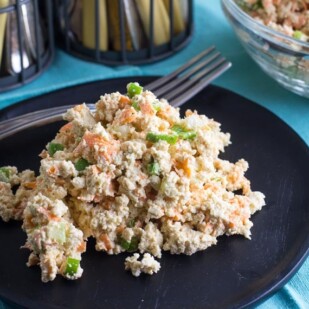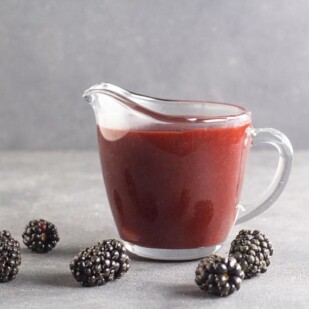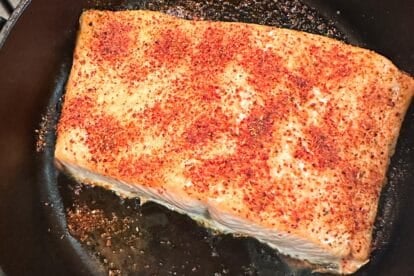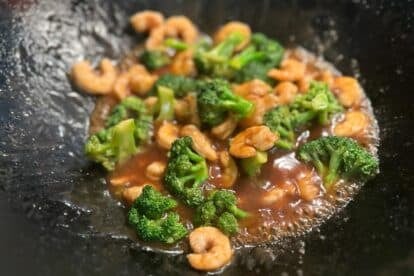Our Low FODMAP Tofu Bánh Mì is a plant-based version of the Vietnamese classic. If you’ve been on the plant-based train for a while, you know the entire spectrum of flavor that unlocks when you begin experimenting in the wild world of herbs, sauces, and spices.
This simple Low FODMAP Bánh Mì sandwich features tofu, pickled veggies, lemongrass, ginger, cilantro, jalapeno, lime, and toasted sesame oil at center stage, for the perfect balance of sweet, salty, sour, freshness, and umami.
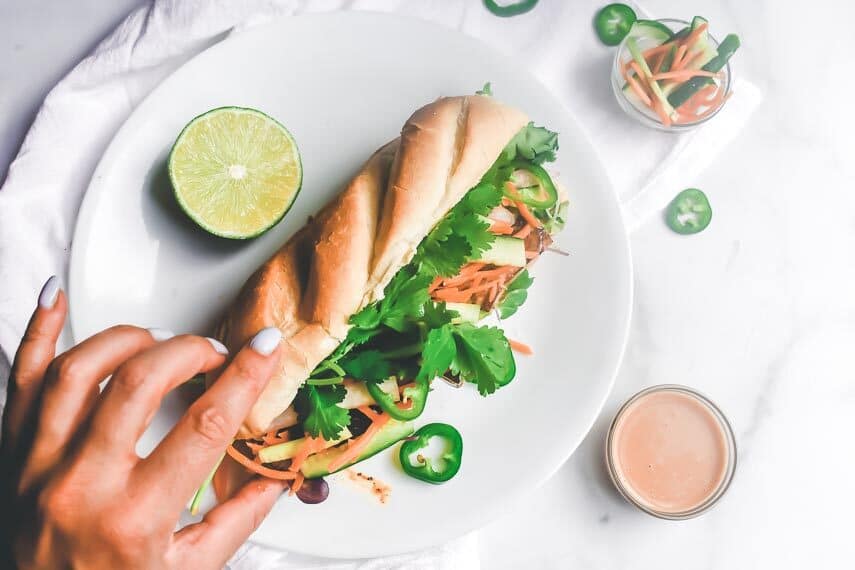
Soy Products Can Be Low FODMAP
Soy products can be confusing as some are low FODMAP and some are not (dried mature soybeans are high FODMAP; young frozen edamame are low FODMAP, for example). You can read more in our articles, Soy Products – Low FODMAP or Not?, Are Soy Sauce & Tamari Low FODMAP? and also Soy And The Low FODMAP Diet.
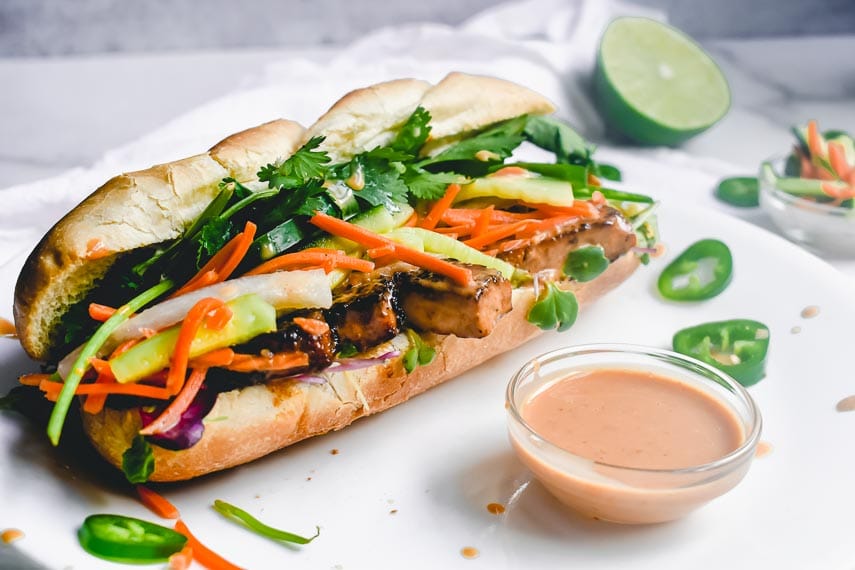
For this recipe we are concerned with tofu and soy sauce. For tofu you want firm or extra-firm tofu (also called firm or plain on the Monash app). These types of tofu have been pressed and drained enough to remove enough Oligosaccharides to be low FODMAP. Silken and soft tofu are not drained as thoroughly and have retained higher levels of FODMAPs.
Soy sauce and tamari are both low FODMAP. In general, we like using low-sodium gluten-free versions, such as those made by San-J. At the very least, use a naturally brewed soy sauce; some are chemically processed, such as La Choy and we do not recommend them. They can literally ruin your whole dish with harsh, acrid flavors.
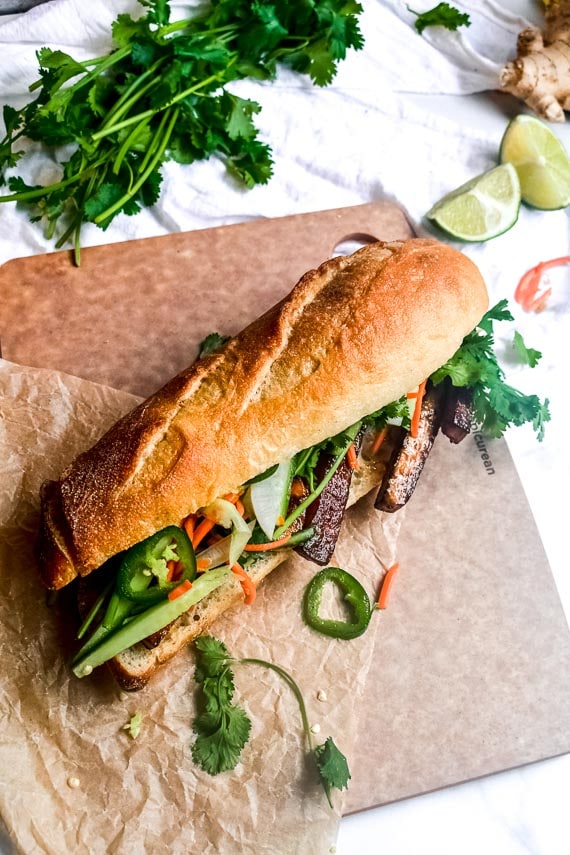
Bánh Mì is a Vietnamese sandwich that originates in Saigon, known for its emblematic mixture of Vietnamese and French cooking elements. The name “Bánh Mì” itself translates to the word “bread.”
In its traditional preparation, Bánh Mì includes a mouth-watering combination of marinaded meat (typically pork or beef), pickled vegetables, cilantro, and jalapenos, served alongside a rich pate-based sauce, on top of a fresh, French baguette.
In addition to its delicious and inimitable flavor profile, this sandwich offers beautiful, complex insight into the evolution of modern Vietnam through its hybrid combination of Vietnamese and French ingredients. We strongly encourage those who are interested to learn about the deeper roots of Bánh Mì and its history, perhaps while enjoying this simplified, plant-based, and low FODMAP rendition!
As we discuss in our Plant-Based Low FODMAP hub article, you don’t have to go vegan or even vegetarian to reap the rewards (and flavors!) of a plant-based diet. The same applies to this recipe. You’ll notice that we still use fish sauce and mayonnaise for our Bánh Mì sauce, for example, which means that this is not a vegan recipe. It is, however, still considered a plant-based dish due to the proportion of plant ingredients to non-plant ingredients. As always, please adapt to meet your specific dietary preferences.
Asafetida (Ferula asafoetida), also spelled asafoetida and referred to as hing, is a seasoning in powder form that is found frequently in Indian cooking and brings a garlic-like flavor to your dish. It is a gum resin extracted from the roots of ferula plants, a perennial herb in the celery family Umbelliferae. It takes the form of a yellowish powder and is often packaged along with wheat starch, in which case it would not be gluten-free, but it is low FODMAP. It has been lab tested by Monash and is low FODMAP in 1 /4 teaspoon (2 g) amounts.
The smell can be off-putting and can be described as sulfuric and egg-like, and in fact has a nickname – “stinking gum”. Those who use it and love it warn others and newbies not to be put off by the smell, which dissipates upon cooking.
The best way to use asafetida is to “bloom” it in hot fat as we do in this recipe. Add oil, ghee, or other fat to your pan, add a tiny bit of asafetida and allow it to toast for about 30 seconds, then go on with the rest of your recipe.
Lemongrass paste is a prepared product that offers a shortcut to using this flavorful ingredient. Sometimes you can find it in a tube, other times in a jar and they are often found in the refrigerated produce section of the supermarket.
Read labels. Some contain fructose, and even garlic and onion, or other high FODMAP ingredients. Others contain vinegar and/or oil or a bit if sugar, but these are not a FODMAP issue.
We like Gourmet Garden Lemongrass. You might notice that it does contain whey derived from milk, but for the 1 teaspoon serving size the sugars total 0 g and the total carbs are 2 g. This will be tolerated by most.
You can, but fresh lemongrass can be laborious to use from fresh. It is very stringy and hard and there is a fair amount of waste involved. You can use fresh if you like. Cut away the meaty, whiteish bulb portion of the lemongrass, stripping away any hard outer and upper stalks. Mash the bulb with the broad side of a heavy cleaver, then mince as finely as possible. Measure out the amount called for in the ingredients.
The bread in the images is a low FODMAP sourdough baguette; this recipe is not gluten-free, but neither is the low FODMAP diet. We have much more info for you about how to select the right bread for you. Read our article How To Choose Low FODMAP Bread. Use the bread that is right for you, but a sturdy baguette-like roll/bread is what you need to soak up juices and not fall apart.
Ingredients
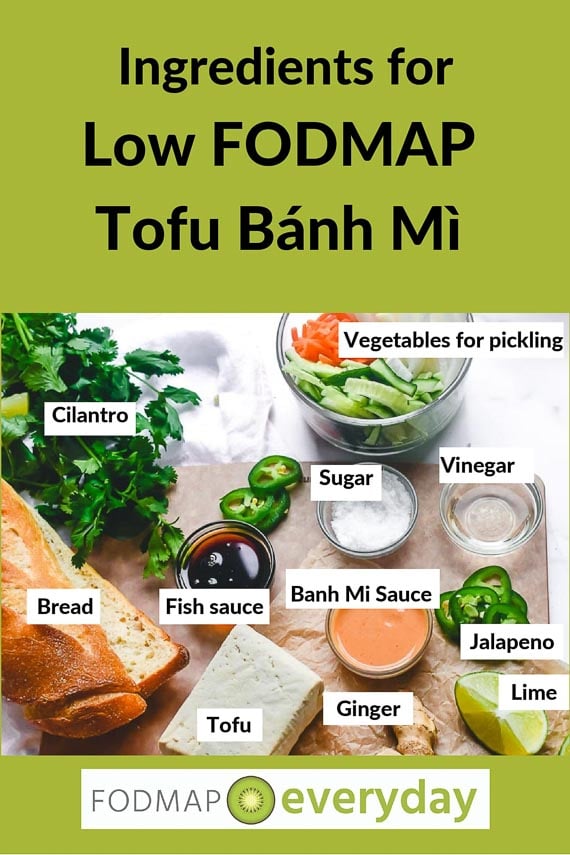
How To Make Low FODMAP Tofu Bánh Mì
Prepare your quick pickled vegetables by combining the cucumbers, carrots, daikon radish, water, rice wine vinegar, and sugar in a small glass jar or plastic container.
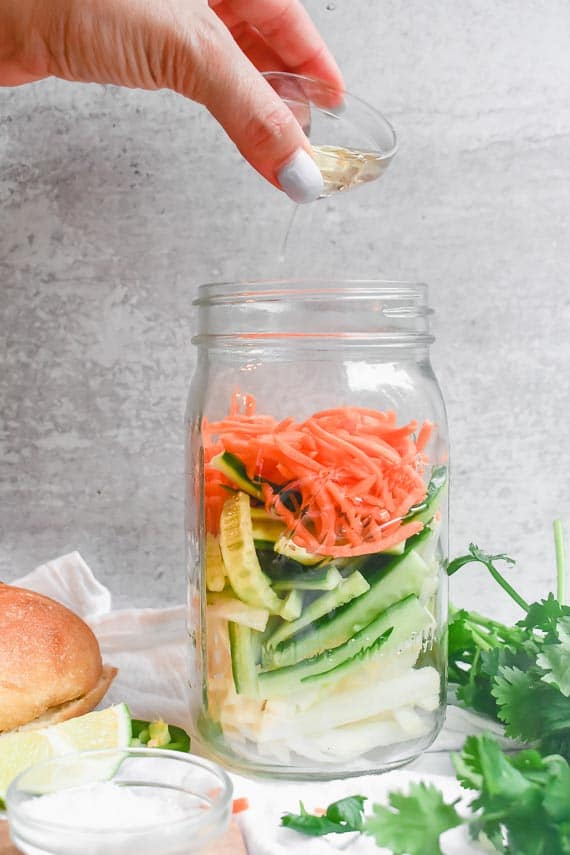
Mix well, cover, and store in room temperature for the duration of the cooking time. (You can refrigerate any extra and save for another week!)
Prep your tofu by wrapping it with a dry paper towel or cheese cloth and gently pressing down on it to remove excess moisture. Cut the tofu into the desired shape for your sandwich – 3-inch-long (7.5 cm) strips work well for this recipe. Set aside.
In a medium mixing bowl, make your tofu marinade by combining fresh ginger root, sesame oil and soy sauce. Mix well. Gently fold in tofu strips to the marinade until each piece is well-coated.
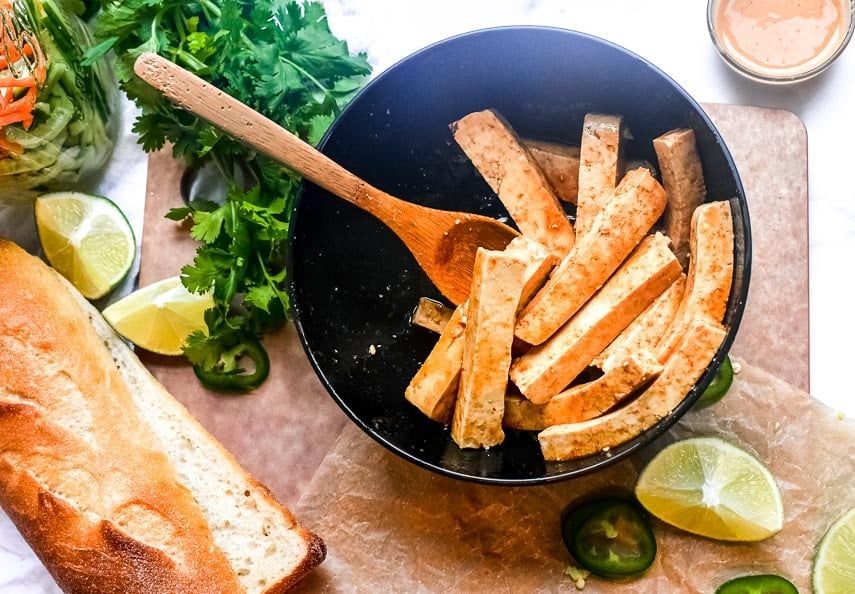
Heat a medium-sized frying pan over medium heat and add avocado oil; heat until oil shimmers. Add the asafetida and allow it to toast on the pan until aromatic – about 30 seconds. Add marinated tofu pieces to your pan. Be mindful not to overcrowd and ensure that each piece lies flat with direct contact on the hot pan – this is how we get that crispy on the outside, soft on the inside texture!
While your tofu cooks, prep your Banh Mi sauce by mixing the mayonnaise, fish sauce, sriracha, ginger, lemongrass, lime juice, soy sauce and sugar in a small, clean mixing bowl. Whisk well and set aside.
Return to your pan and one-by-one, flip each marinaded tofu strip to that both sizes become crispy, golden brown.
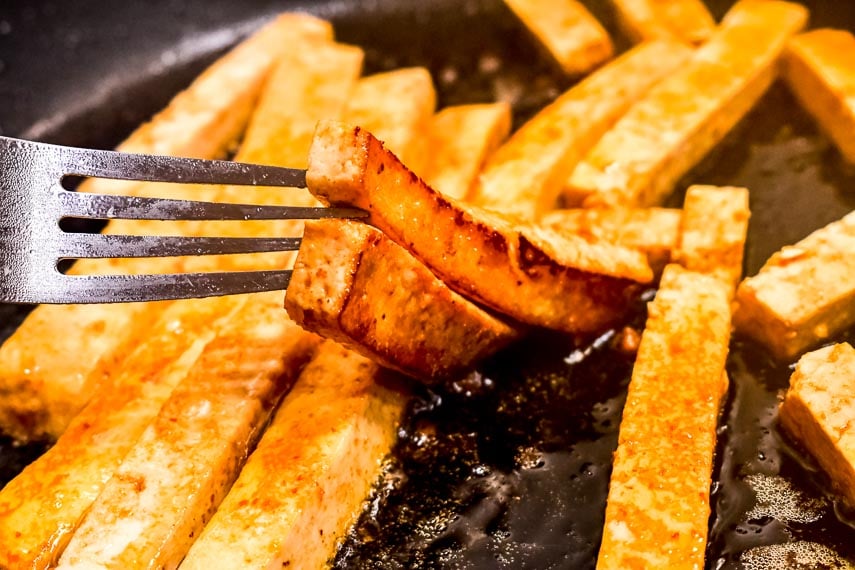
It will take about 5 minutes to brown each side, for a total of 10 minutes for both sides to become crisp and golden.
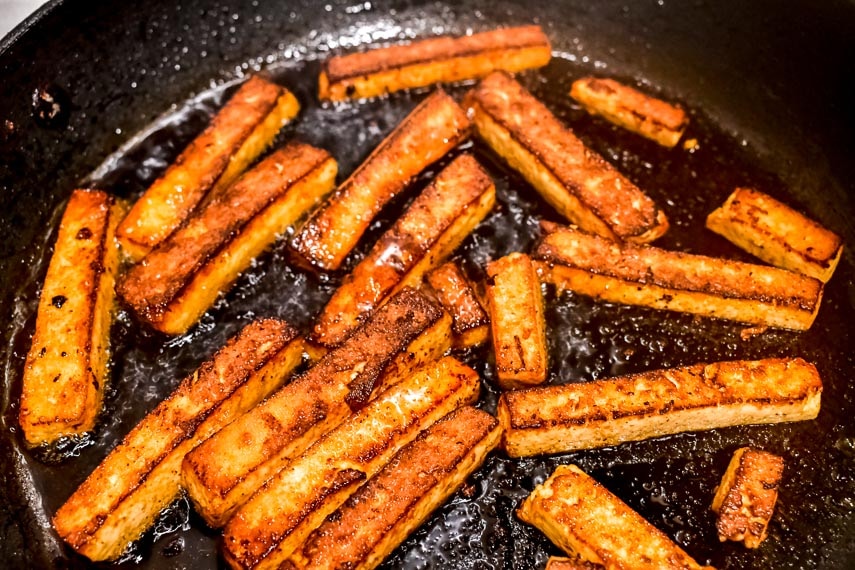
While your tofu finishes browning on the second side, prep your sandwich bread and garnish. Cut your low FODMAP baguette of choice to 6-inches (15 cm) in length (optional: toast in the oven at 375°F /190°C for 10 minutes to warm it up!).
Once your tofu has browned on both sides, remove it from heat. Add the cooked tofu strips to your Banh Mi sauce mixture, and gently fold together until the strips are well-coated.
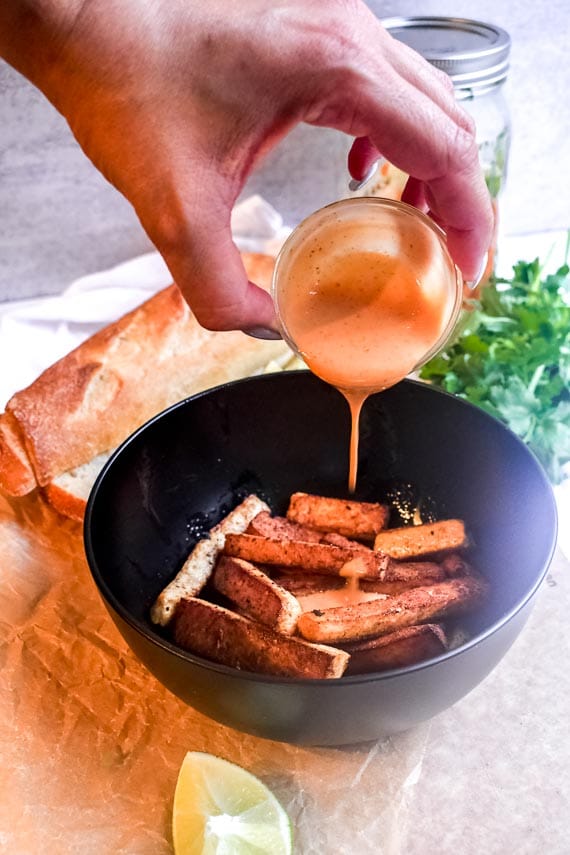
Now it’s time to assemble your sandwich! Open your baguette (or low FODMAP bread of choice) and add cooked and coated tofu.
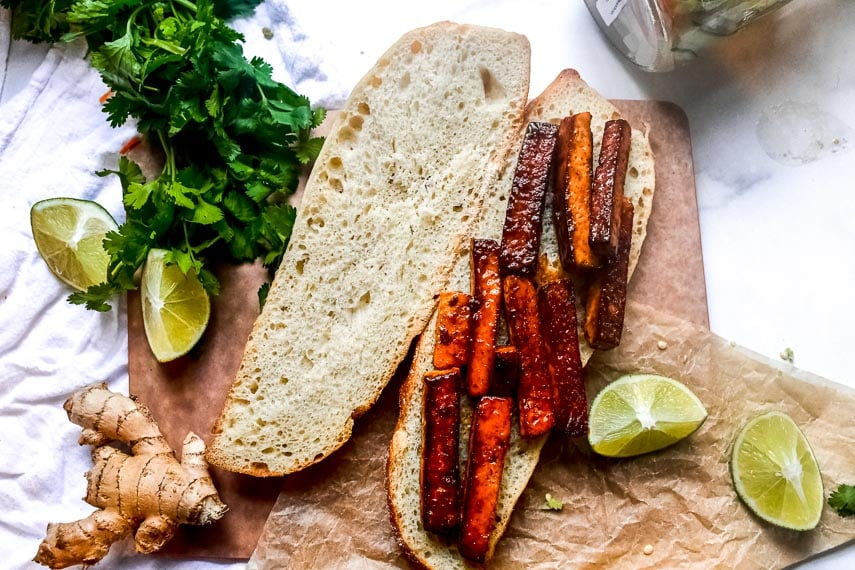
Add your desired amounts of pickled vegetables, cilantro and jalapeno. Slice in half to make two sandwiches.
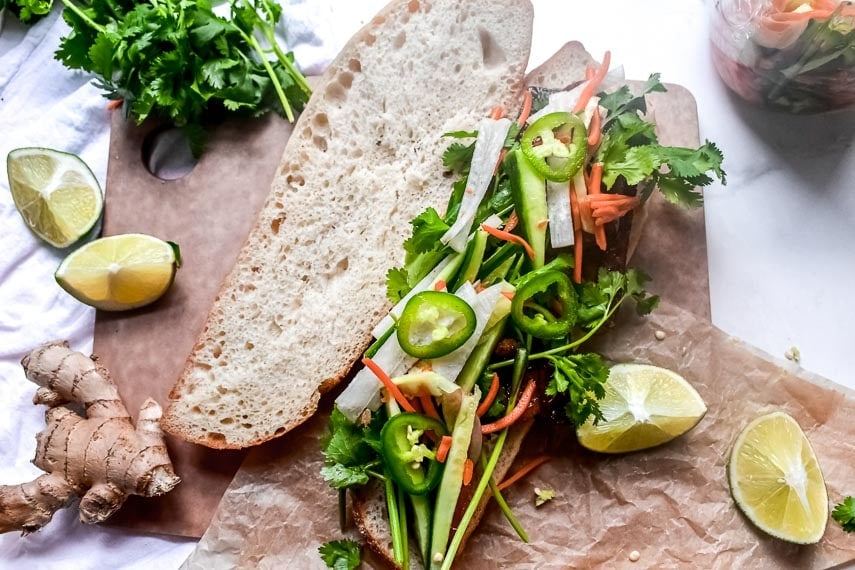
Serve immediately and enjoy!
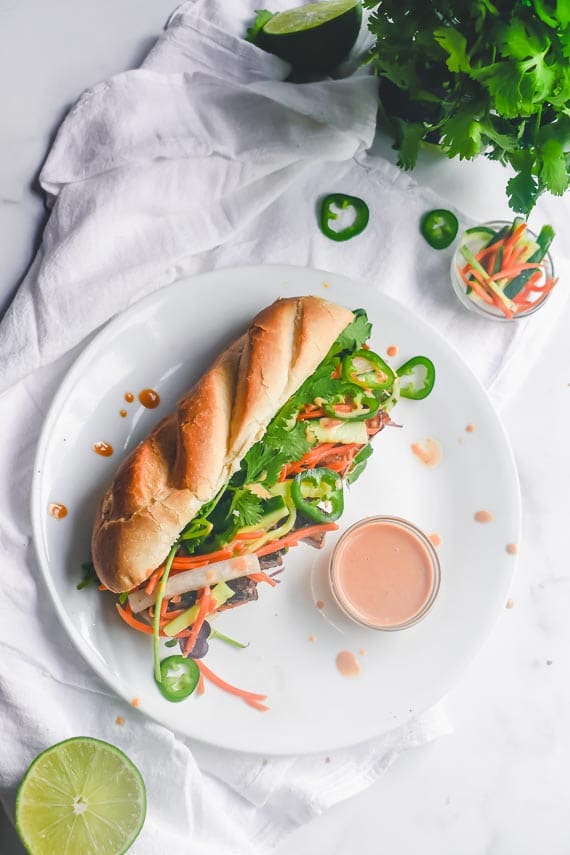
More Plant-Based Recipes
We have hundreds of plant-based recipes for you to try. Here are just some of our favorites.
- Baja Tempeh Taco Salad
- Plant-Based New Orleans Gumbo
- Za’atar Spiced Tofu Scramble
- Tofu Salad
- Chickpea Salad
- Thai Tofu Curry
- Roasted Root Vegetable Tian
- Two-Mushroom Miso Soup
- Roasted Root Vegetable Soup
- Tempeh Lentil Chili
- Cinnamon Apple Breakfast Cookies
- Roasted Pumpkin Quinoa Salad
- Loaded Low FODMAP Kale Chips
- Vegan Chocolate Chunk Cookies
FODMAP Information
Our recipes are based on Monash University and FODMAP Friendly science.
- Carrots: Carrots have been lab tested and deemed low FODMAP by both Monash University and FODMAP Friendly. According to Monash carrots contain no FODMAPs.
- Cucumbers: Both Monash University and FODMAP Friendly have lab tested cucumbers. FODMAP Friendly gives them a “Pass” at ½ cup (64 g). Monash states that no FODMAPs were detected upon lab testing and set a serving size at ½ cup (75 g).
- Daikon: This white radish has been lab tested by Monash and they are low FODMAP in servings of ½ cup (75 g).
- Firm Tofu: The quantity of tofu used for two servings of this recipe contains 80% the recommended low FODMAP quantity of mannitol. All other ingredients in the recipe contain 1% or less the recommended low FODMAP quantity of mannitol.
- Lime Juice: Monash University has lab tested lime juice and it is low FODMAP in 1 cup (250 g) amounts (double that of lemon juice, as an interesting fact).
- Low FODMAP Baguette: The bread used in the images for this recipe is a 6-inch (15 cm) low FODMAP sourdough baguette. It contains gluten; the low FODMAP diet is neither wheat-free nor gluten-free. If you do restrict gluten and have not completed the Elimination and Challenge phases of your low FODMAP diet, please adjust the recipe to your tolerance and preferences. You can read more about how to select the bread that is right for you in our article, How To Choose Low FODMAP Bread.
- Mayonnaise: Both Monash University and FODMAP Friendly have lab tested mayonnaise. Monash has also tested a low fat version. They all agree that a low FODMAP serving size is 40 g or 2 Australian tablespoons (for low fat, too). Some mayonnaise can contain natural flavors that are derived from onion and/or garlic. Neither of the certifying bodies has told us if the mayonnaise they tested did or did not contain such ingredients. Certainly if garlic or onion are listed as line items on the label, you might look for a different brand.
- Oil: All pure oils are fats and contain no carbohydrates, therefore they contain no FODMAPs.
- Sugar: Monash University and FODMAP Friendly have both lab tested white, granulated sugar. Monash states that a Green Light low FODMAP serving size of white sugar is ¼ cup (50 g). FODMAP Friendly simply states that they have tested 1 tablespoon and that it is low FODMAP. Regular granulated white sugar is sucrose, which is a disaccharide made up of equal parts glucose and fructose. Sucrose is broken down and absorbed efficiently in the small intestine.
- Vinegar: Several vinegars have been lab tested by both Monash and FODMAP Friendly. From Monash: Apple cider vinegar is low FODMAP at 2 Australian tablespoons or 42 g; Balsamic vinegar is low FODMAP at 1 Australian tablespoons or 21 g; Malt vinegar contains no FODMAPs; Rice wine vinegar is low FODMAP at 2 Australian tablespoons or 42 g. From FODMAP Friendly: Balsamic gets a “Pass” at 2.5 tablespoons or 42 ml. Apple cider vinegar gets a “Pass” at 1 tablespoon or 14 g (don’t ask me why one is in milliliters and the other in grams).
Please always refer to the Monash University & FODMAP Friendly smartphone apps for the most up-to-date lab tested information. As always, your tolerance is what counts; please eat accordingly. The ultimate goal of the low FODMAP diet is to eat as broadly as possible, without triggering symptoms, for the healthiest microbiome.
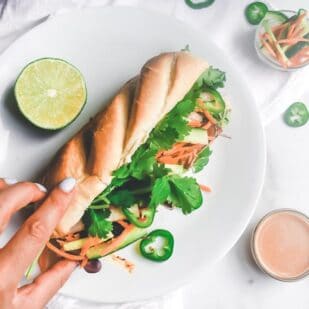
Low FODMAP Tofu Bánh Mì
Our Low FODMAP Tofu Bánh Mì is a plant-based version of the Vietnamese classic. If you’ve been on the plant-based train for a while, you know the entire spectrum of flavor that unlocks when you begin experimenting in the wild world of herbs, sauces, and spices. This simple Low FODMAP Bánh Mì sandwich features tofu, pickled veggies, lemongrass, ginger, cilantro, jalapeno, lime, and toasted sesame oil at center stage, for the perfect balance of sweet, salty, sour, freshness, and umami.
Ingredients:
For Pickled Veggies:
- 1/2 cup (75 g) long matchsticks of peeled daikon radish
- 1/2 cup (75 g) long matchsticks of hothouse cucumber (no need to peel)
- 1/2 cup (75 g) long matchsticks of peeled carrots
- 1/4 cup (60 ml) water
- 1 tablespoon rice wine vinegar
- 1 tablespoon sugar
For Tofu:
- 7- ounces (200 g) firm or extra-firm tofu, drained
- 1 teaspoon minced fresh ginger root
- 1 teaspoon toasted sesame oil
- 1/2 teaspoon soy sauce
- 1 tablespoon avocado oil or other neutral flavored oil
- 1/4 teaspoon asafetida
For Banh Mi Sauce:
- ¼ cup (80 g) low-fat mayonnaise
- 2 teaspoons fish sauce
- 2 teaspoons sriracha
- 1 teaspoon minced fresh ginger root
- 1 teaspoon fresh lemongrass paste
- 1 teaspoon lime juice
- 1 teaspoon soy sauce
- 1 teaspoon sugar
For Sandwich + Toppings:
- 6- inch (15 cm) low fodmap baguette
- 1/4 cup (4 g) cilantro sprigs
- 1 tablespoon fresh jalapeno slices
Preparation:
-
Prepare your quick pickled vegetables: Combine the cucumbers, carrots, daikon radish, water, rice wine vinegar, and sugar in a small glass jar or plastic container. Mix well, cover, and store in room temperature for the duration of the cooking time. (You can refrigerate any extra and save for another week!)
-
Prep your tofu by wrapping it with a dry paper towel or cheese cloth and gently pressing down on it to remove excess moisture. Cut the tofu into the desired shape for your sandwich – 3-inch-long (7.5 cm) strips work well for this recipe. Set aside.
-
In a medium mixing bowl, make your tofu marinade by combining fresh ginger root, sesame oil and soy sauce. Mix well. Gently fold in tofu strips to the marinade until each piece is well-coated.
-
Heat a medium-sized frying pan over medium heat and add avocado oil; heat until oil shimmers. Add the asafetida and allow it to toast on the pan until aromatic – about 30 seconds. Add marinated tofu pieces to your pan. Be mindful not to overcrowd and ensure that each piece lies flat with direct contact on the hot pan – this is how we get that crispy on the outside, soft on the inside texture!
-
While your tofu cooks, prep your Banh Mi sauce by mixing the mayonnaise, fish sauce, sriracha, ginger, lemongrass, lime juice, soy sauce and sugar in a small, clean mixing bowl. Whisk well and set aside.
-
Return to your pan and one-by-one, flip each marinaded tofu strip to that both sizes become crispy, golden brown. It will take about 5 minutes to brown each side, for a total of 10 minutes.
-
While your tofu finishes browning on the second side, prep your sandwich bread and garnish. Cut your low FODMAP baguette of choice to 6-inches (15 cm) in length (optional: toast in the oven at 375°F /190°C for 10 minutes to warm it up!).
-
Once your tofu has browned on both sides, remove it from heat. Add the cooked tofu strips to your Banh Mi sauce mixture, and gently fold together until the strips are well-coated.
-
Now it’s time to assemble your sandwich! Open your baguette (or low FODMAP bread of choice) and add cooked and coated tofu. Add your desired amounts of pickled vegetables, cilantro and jalapeno, slice in half to make two sandwiches and enjoy!
Notes:
- It is crucial to cook the asafetida in a small amount of oil before adding the remainder of your ingredients to the pan. Remember that this delicious, low FODMAP allium alternative is quite pungent. Toasting the spice in oil allows for the aroma to come through and some of the sharpness to be tempered.
- Use a reduced sodium soy sauce to moderate total sodium content of the recipe if needed.
FODMAP Information
Our recipes are based on Monash University and FODMAP Friendly science.
• Carrots: Carrots have been lab tested and deemed low FODMAP by both Monash University and FODMAP Friendly. According to Monash carrots contain no FODMAPs.
• Cucumbers: Both Monash University and FODMAP Friendly have lab tested cucumbers. FODMAP Friendly gives them a “Pass” at ½ cup (64 g). Monash states that no FODMAPs were detected upon lab testing and set a serving size at ½ cup (75 g).
• Daikon: This white radish has been lab tested by Monash and they are low FODMAP in servings of ½ cup (75 g).
• Firm Tofu: The quantity of tofu used for two servings of this recipe contains 80% the recommended low FODMAP quantity of mannitol. All other ingredients in the recipe contain 1% or less the recommended low FODMAP quantity of mannitol.
• Lime Juice: Monash University has lab tested lime juice and it is low FODMAP in 1 cup (250 g) amounts (double that of lemon juice, as an interesting fact).
• Low FODMAP Baguette: The bread used in the images for this recipe is a 6-inch (15 cm) low FODMAP sourdough baguette. It contains gluten; the low FODMAP diet is neither wheat-free nor gluten-free. If you do restrict gluten and have not completed the Elimination and Challenge phases of your low FODMAP diet, please adjust the recipe to your tolerance and preferences. You can read more about how to select the bread that is right for you in our article, How To Choose Low FODMAP Bread.
• Mayonnaise: Both Monash University and FODMAP Friendly have lab tested mayonnaise. Monash has also tested a low fat version. They all agree that a low FODMAP serving size is 40 g or 2 Australian tablespoons (for low fat, too). Some mayonnaise can contain natural flavors that are derived from onion and/or garlic. Neither of the certifying bodies has told us if the mayonnaise they tested did or did not contain such ingredients. Certainly if garlic or onion are listed as line items on the label, you might look for a different brand.
• Oil: All pure oils are fats and contain no carbohydrates, therefore they contain no FODMAPs.
• Sugar: Monash University and FODMAP Friendly have both lab tested white, granulated sugar. Monash states that a Green Light low FODMAP serving size of white sugar is ¼ cup (50 g). FODMAP Friendly simply states that they have tested 1 tablespoon and that it is low FODMAP. Regular granulated white sugar is sucrose, which is a disaccharide made up of equal parts glucose and fructose. Sucrose is broken down and absorbed efficiently in the small intestine.
• Vinegar: Several vinegars have been lab tested by both Monash and FODMAP Friendly. From Monash: Apple cider vinegar is low FODMAP at 2 Australian tablespoons or 42 g; Balsamic vinegar is low FODMAP at 1 Australian tablespoons or 21 g; Malt vinegar contains no FODMAPs; Rice wine vinegar is low FODMAP at 2 Australian tablespoons or 42 g. From FODMAP Friendly: Balsamic gets a “Pass” at 2.5 tablespoons or 42 ml. Apple cider vinegar gets a “Pass” at 1 tablespoon or 14 g (don’t ask me why one is in milliliters and the other in grams).
Please always refer to the Monash University & FODMAP Friendly smartphone apps for the most up-to-date lab tested information. As always, your tolerance is what counts; please eat accordingly. The ultimate goal of the low FODMAP diet is to eat as broadly as possible, without triggering symptoms, for the healthiest microbiome.
Nutrition
All nutritional information is based on third-party calculations and should be considered estimates. Actual nutritional content will vary with brands used, measuring methods, portion sizes and more. For a more detailed explanation, please read our article Understanding The Nutrition Panel Within Our Recipes.
